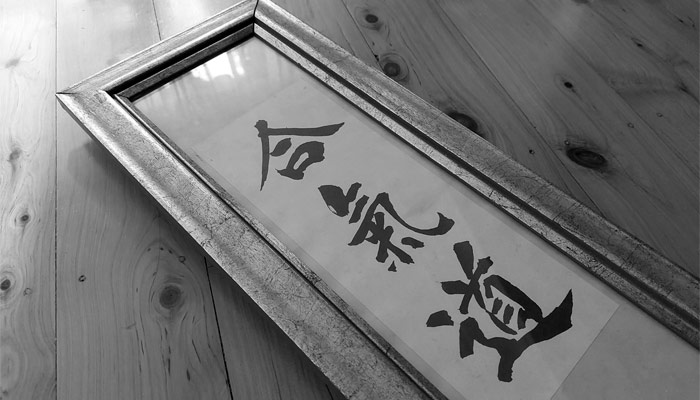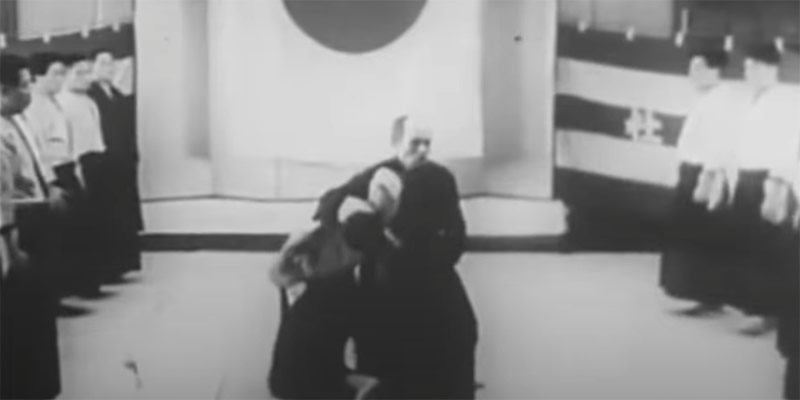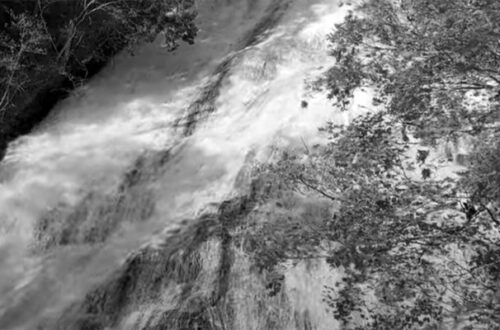
A Journey of Naming: From Daito Ryu to Aikido (Part II)
Around 1934, Ueshiba received an invitation from Takuma Hisa 久琢磨, who was associated with the Osaka Asahi Shinbun 朝日新聞, one of Japan’s major and oldest national daily newspapers, to teach in Osaka. Ueshiba would regularly travel to the Asahi Dojo and taught there for about 3 years. During this period, Ueshiba referred to his art as Dai Nippon Asahi Ryu 大日本旭流.
During his time in Osaka, Hisa and others who received instruction took advantage of the resources available at the newspaper company to meticulously document each technique and capture them in photographs and videos. These materials, along with the techniques Hisa later learned directly from Takeda Sokaku, were compiled into the eleven volumes of Daito Ryu Aiki Budo Densho 大東流合気武道傳書. The first six volumes are titled Asahi Ryu Jujutsu 旭流柔術, primarily focusing on techniques taught by Ueshiba.

Ueshiba demonstrating in a video produced by Osaka Asahi Shinbun 朝日新聞 (Directed by Takuma Hisa 久琢磨)
In 1940, the Kobukan officially incorporated as a non-profit organization in Japan, under the name Zaidan Hojin Kobukai 財団法人皇武会 (Kobukai Foundation). Two years later, the Japanese government assumed control of Dai Nihon Butokukai 大日本武徳会, a martial arts foundation established during the Meiji era to promote traditional Japanese martial arts. The government initiated a restructuring effort to bring all martial arts groups in Japan under government jurisdiction. This was jointly managed by five government ministries, including Prime Minister Hideki Tojo 東條 英機, emphasizing its role as a wartime cooperation organization.
Various divisions (部) were established for different martial arts disciplines such as Kendo 剣道, Judo 柔道, Karate 空手, and Jukendo 銃剣道. This allowed for better control and also contributed to the promotion of each martial art. A significant aspect of this effort was the standardization of names for martial arts schools throughout the country.
Kobukai was also invited to participate in this initiative. At the time, some of the divisions were already well developed; however, Ueshiba’s art, along with numerous other Jujutsu styles didn’t fit neatly into any of them. Dai Nihon Butokukai decided to create a new division to accommodate them. Initially, the name “Aiki Budo” was proposed by Minoru Hirai 平井稔, who represented Kobukai. However, after extensive negotiations, the name “Aikido 合気道” was chosen instead. The detailed specifics of these negotiations won’t be delved into here. Nevertheless, the new division was officially recognized as Dai Nihon Butokukai Aikido Division 大日本武徳会合気道部.
Following Japan’s defeat in 1945, after the conclusion of World War II, the Butokukai was privatized and its control over various martial arts organizations ceased to exist. It was eventually ordered to dissolve by the Supreme Commander for the Allied Powers. Martial arts were prohibited as they were seen as fostering the regimentation and nationalistic fervor that had contributed to militarism. Consequently, Kisshomaru Ueshiba and the administration of Kobukai resettled in Iwama the following year to ensure the survival of the art (Note: Morihei Ueshiba had already moved to Iwama in 1942).

Old Hombu Dojo (Left: Aikido Hombu Ueshiba Dojo, Right: Zaidan Hojin Aikikai)
In 1948, Kisshomaru returned to Tokyo and began the process of rebuilding the dojo. Through the efforts of many, the organization was officially approved by the Ministry of Education under the new name “Zaidan Hojin Aikikai 財団法人合気会” (Aikikai Foundation) in the same year. Training officially resumed, and the name Aikido was formally adopted. Consequently, some of Ueshiba’s students believed that the term Aikido was only introduced after the war.
The timeline presented in these two parts offers a rough overview of the names used during different periods, drawing from the recollections of Ueshiba’s son Kisshomaru and other students. While Ueshiba used various names for his art, it wasn’t until after 1948 that the name Aikido became widely accepted and used.
Suggested Reading: A Journey of Naming: From Daito Ryu to Aikido (Part I)
Author’s Note: We appreciate your readership! This article serves as a preliminary introduction to the subject matter. While we aim for accuracy, we cannot guarantee the content’s precision and it may contain elements of speculation. We strongly advise you to pursue additional research if this topic piques your interest. Begin your AikidoDiscovery adventure! 🙂





3 Comments
Ted Howell
Hello, although you add the disclaimer regarding the accuracy of the material, I thought it would be important to point out some issues.
Firstly, I would be interested in your references. Some historical claims appear to be pure speculation.
1. The Dai Nihon Butokukai did not create a division within the organization to accomodate Ueshiba’s martial art. The new division was created with the intent to bring numerous schools of jujutsu under the unbrella of the DNBK. Ueshiba’s art was one of many.
2. The name “Aikido” was a generic term given to the new division, referring to all DNBK Jujutsu.
The name was later “appropriated” by Ueshiba, after it was used by the DNBK.
Please visit our website for accurate information.
Ted Howell
AikidoDiscovery Admin
Hi Ted, thank you so much for taking the time to leave a comment on my blog. I truly appreciate your engagement and feedback. I’d like to extend my apologies for not responding sooner. Since this blog is more of a personal interest and not monitored regularly, there may be occasional delays in my responses.
Your comment is valuable to me, and I’m encouraged by your input. I will definitely continue my research based on your comment and refine the essay accordingly. Once again, thank you for your comment.
Ted Howell
Hello,
I appreciate your willingness to revisit your research. Please let me know if I can be of any assistance. You may contact me directly or through the Aiki Martial Arts Institute.
Ted Howell